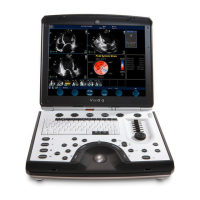GE HEALTHCARE
DIRECTION FQ091013, REVISION 1 VIVID I N AND VIVID Q N SERVICE MANUAL
Chapter 10 - Care and Maintenance 10-21
Section 10-7
Electrical Safety Tests
10-7-1 Safety Test Overview
The electrical safety tests in this section are based on and conform to NFPA 99 (For USA) and IEC
60601-1 Medical Equipment Safety Standards. They are intended for the electrical safety evaluation of
cord-connected, electrically operated, patient care equipment. If additional information is needed, refer
to the NFPA 99 (for USA) and IEC 60601-1 documents.
WARNING:
THE USER MUST ENSURE THAT THE SAFETY INSPECTIONS ARE
PERFORMED AT LEAST EVERY 12 MONTHS ACCORDING TO THE REQUIREMENTS OF
THE PATIENT SAFETY STANDARD IEC-EN 60601-1. ONLY TRAINED PERSONS ARE
ALLOWED TO PERFORM THE ABOVE-MENTIONED SAFETY INSPECTIONS.
CAUTION: To avoid the risk of electrical shock, the unit under test must not be connected to
other electrical equipment. Remove all interconnecting cables and wires. The operator and
patient must not come into contact with the unit while the tests are being performed.
CAUTION: Possible risk of infection. Do not handle soiled or contaminated probes and other
components that have been in patient contact. Follow appropriate cleaning and disinfecting
procedures before handling the equipment.
Test the system, peripherals and probes for current leakage.
WARNING:
EXCESSIVE CURRENT LEAKAGE CAN CAUSE FATAL INJURY.
EXCESSIVE CURRENT LEAKAGE CAN INDICATE DEGRADATION OF INSULATION OR
OTHER PART AND COULD POTENTIALLY CAUSE ELECTRICAL FAILURE. DO NOT
USE PROBES OR EQUIPMENT THAT HAVE EXCESSIVE CURRENT LEAKAGE.
Important: When the SafeLock Cart is connected to the wall outlet and the main circuit breaker is in the
ON position, the AC Box Fan is operated - even if the system power is turned OFF.
To minimize the risk of a probe causing electrical shock, the customer should observe the following
recommendations:
• Do not use a probe that is cracked or damaged in any way
• Check probe current leakage, as shown below:
NOTE: Because the Vivid i n/ Vivid q Nscanner is operated from low voltage DC (considered extremely safe
extra low voltage) and because the transformer is enclosed in plastic parts only (and therefore does not
have any accessible metal parts), when the scanner is not mounted on the SafeLock Cart, it is not
necessary to perform the following safety tests (i.e., they apply only to the SafeLock Cart itself):
• Chassis Current Leakage Test
• Grounding Continuity Test
Probe Frequency for Checking
Surface
Once per year
(or in accordance with QA program)
Endocavitary
Twice per year
(or in accordance with QA program)
Any probe
Whenever damage is suspected

